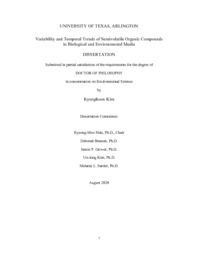| dc.description.abstract | Exposure to semivolatile organic compounds (SVOCs) in indoor environments and its potential impact on human health have been receiving increased public attention, because people in developed countries spend over 80% of their time indoors, SVOC levels are several orders of magnitude higher indoors than outdoors, and many SVOCs have various toxicities and endocrine disrupting potential. Concentrations of SVOCs in biological (e.g., human serum) and environmental (e.g., household dust, indoor air) media can help us better understand human exposure to SVOCs. For example, SVOC concentrations in biological media collected over several years may shed light on temporal trends of exposure due to the changes in consumer use or regulations. In addition, SVOC concentrations in indoor dust repeatedly collected in the same home may allow us to examine temporal variability of exposure via non-dietary dust ingestion. Lastly, SVOC concentrations in upholstered home furniture with frequent skin contact may improve our understanding of exposure via direct skin contact with furniture surfaces, particularly for infants and young children.
My dissertation studies include three sub-studies: (1) examining temporal trends and determinants of concentrations of SVOCs in blood serum samples, (2) examining temporal variability of dust concentrations and factors affecting dust concentrations for SVOCs, and (3) evaluating couch polyurethane foam (PUF) for a potential passive sampler of SVOCs.
In the first study, I utilized measured concentrations of per- and polyfluoroalkyl substances (PFAS), one class of SVOCs, in serum collected from California mothers with a young child. Then, I used multiple regression to estimate geometric means of PFAS concentrations for each sampling year (2009-2016), with adjustment for sampling year and other population characteristics that may affect PFAS concentrations in maternal serum. I observed that perfluorooctanoate (PFOA), perfluorooctane sulfonate (PFOS), and perfluorohexane sulfonate (PFHxS) decreased over the study period, consistent with results of some studies reported for other U.S. populations and other studies outside the USA. My study showed that body burden of some common long-chain PFAS decreased over the study period among California mothers with a young child.
In the second study, I utilized measured concentrations of a wide range of SVOCs in dust collected three times from the same home during a period of 22 months. To test for within-home temporal variability of SVOC concentrations in household dust, I computed intraclass correlation coefficients (ICCs), a ratio of between-home variance to total variance (within-home variance + between-home variance). Among 26 compounds that were detected in more than 50% of the samples at all three visits, 20 compounds had ICCs above 0.50 and 6 compounds had ICCs below 0.50. For 19 out of 26 compounds, correlation coefficients between spring and fall (r = 0.48-0.98) were higher than those between summer and winter (r = 0.09-0.92), implying seasonal effects on dust concentrations. My study showed that within-home temporal variability of dust concentrations was small (ICC > 0.50) for most SVOCs, but dust concentrations may vary over time for some SVOCs with seasonal variations in source rates, such as product use.
In the third study, I utilized measured concentrations of non-flame retardant SVOCs in couch PUF at three different depths. Then, I examined concentration changes with depths and developed predictive equations for the PUF-air partition coefficient (KPUF-air). Among 29 detected compounds, 11 compounds were detected in more than 50% of the samples at all depths. Among the 11 compounds, concentrations of phenanthrene, 2-benzylideneoctanal, galaxolide, tonalide, and homosalate decreased with depth. Among the studied SVOCs, calculated log KPUF-air values varied from 2.46 (dimethyl phthalate) to 7.80 (homosalate), and Koa (r2 = 0.62) was a stronger predictor of KPUF-air than VP (r2 = 0.47). My study showed that couch PUF can absorb many SVOCs but may not be an effective passive sampling medium for those that were less frequently detected in couch PUF and had low correlation coefficients between concentrations in dust and PUF. | |


